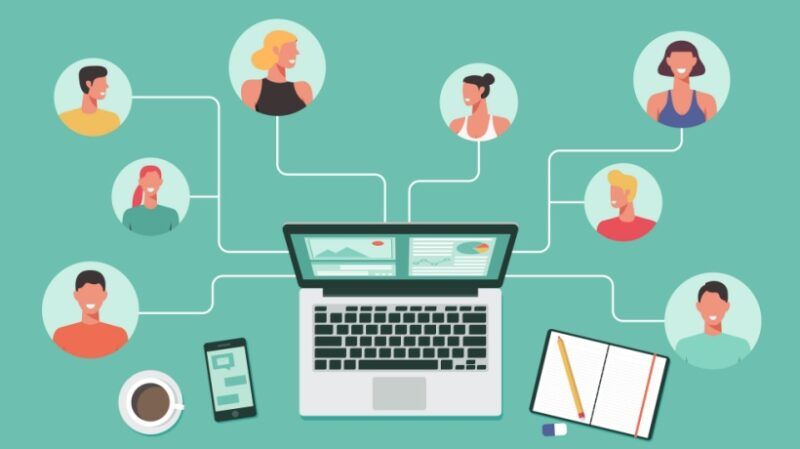
The Impact Of Social Media On eLearning
The integration of social media into the education system has drastically changed the academic culture and environment. Whether this consolidation is healthy for the education system or a decline, it has long been debated right from the start of this inclusion. Well, several examples come to mind where social media is helping the education system. For example, it helps students get easy access to plenty of data that may sometimes be difficult to gather in person. On the other hand, the authenticity of this data is another concern raised by academic professionals.
This article is a detailed account of the potential advantages or importance of social media in the eLearning industry. As well as this, we also discuss possible drawbacks which may make social media a bad choice for the education system. By addressing these concerns, we can avoid potential issues faced by students, teachers, or even organizations while pursuing education through social media.
Benefits Of Social Media In eLearning
Let’s explore how social media helps online education systems or eLearning:
1. Improved Communication
Social media channels have evolved enough that they offer users better, more effective, and faster communication. It has enabled students, teachers, and even educational organizations to ensure an instant, convenient, and widespread exchange of data. With this real-time interaction, a collaborative learning opportunity along with quick feedback on assignments has become possible.
This improved communication has also created a more interactive and inclusive education or learning environment. It helps us break down physical barriers, encouraging active participation of students and educators throughout the education and learning process.
2. Real-Time Data Access
Social media channels also allow students and teachers to access real-time data, keeping them updated with the current news, trends, and development phases in the eLearning industry. This immediate access to Learning and Development resources and insights can enhance the eLearning experience. Social media also enables the dissemination of academic updates and other important announcements, encouraging a more intellectual and dynamic education environment.
3. Better Growth Opportunities
Social media brings better growth opportunities for instructors and educational organizations. Instructors and educational institutes can showcase their teaching abilities and skills through social media channels, convincing more students to engage with them. For example, sharing helpful study materials through social media channels will not only increase content visibility but also the organization’s credibility as well. Thus, it can bring more opportunities for growth as an educational entity among learners.
4. Instant And Easy Access
Social media has made it possible for students and educational institutes to arrange classroom and study sessions anytime, anywhere. There is no need to gather in a specific space which, sometimes, may take a bit of time and punctuality to manage. Thus, we can say that social media integration with the education system has reduced inefficiency and increased productivity.
Similar to the TikTok educational trend, content creators like Dianna Cowern, aka “The Physics Girl”, make science fun with cool experiments and physics facts. This saves time for both students and educators that would otherwise be spent commuting to educational institutes. Remember, using the best time to post your educational content also ensures that your students will be engaged consistently.
5. Better Student Participation
Social media has made it easy for students to participate in different learning projects or assignments freely and without hesitation. For example, some students may not perform well during physical classes or in-person settings. During online classes, they get enough encouragement to participate and speak about their subjects, assignments, or projects. This encouragement will surely make them able to collaborate and participate during physical presentations.
6. Content Creation Tools
Social media has made it easy for students, educators, and institutions to create helpful and compelling content to be shared across social media. Many students search for helpful content or study materials on social media as short reels and video content. This is because these types of content can help them get maximum knowledge within a short time.
Content creation tools can help creators to supercharge their content. Many social media channels provide creators with helpful and creative tools to create more meaningful and compelling content, helping learners achieve something exceptional. This content creation feature has also reduced the effort required for students to search for content on the internet.
7. Cost-Free Learning
Last but not least, another top benefit of social media in eLearning is that it offers free-of-cost learning and study opportunities. Almost all social media channels allow users to create free profiles, groups, and channels. At the same time, users can share and receive plenty of content without paying even a single cent.
Drawbacks Of Social Media In eLearning
Where we experience the pros of something, there is the possibility of cons as well. When it comes to talking about social media integration in the eLearning or education system, indeed, we find plenty of advantages. However, there are some drawbacks have also been highlighted or reported while using social media as your education companion. Some common ones are listed here with the purpose of helping to diagnose them and eliminate them in your educational setting to create a safe and healthy online learning environment:
1. Distraction Concerns
The main concern related to social media in education is that it can distract students from their studies, leading to a decline in academic performance. Remember that the basic purpose behind creating social media applications is to spread content for entertainment purposes. When you get notifications related to new reels from your favorite creators and some new posts from your friends or family, you will definitely go to check them. This can lead to distraction and an academic decline.
2. Privacy Concerns
Another prevalent concern in social media integration with the education system is privacy. While using social media, students’ personal data can be exposed to everyone. Anyone might be able to contact them and disturb them, leading to cyberbullying and harassment. Educational entities must ensure proactive measures to safeguard the sensitive information of students.
3. Data Authenticity
Social media applications indeed help students a lot in finding and gathering data related to their specific subjects, assignments, or other projects. But, who ensures the authenticity of the given data? Students are at a higher risk of getting misinformation and false data on social media. Educators and educational organizations have to confirm the authenticity and reliability of data and then allow students to use the particular data.
4. Access To Inappropriate Content
Sometimes students may also access inappropriate data, including violence, hate speech, and others. These types of content may have a bad impact on their thoughts, leading them toward bad decisions in life. So, educators as well as parents need to ensure the safe use of social media by their students or children.
Conclusion
Indeed, social media applications have become the most prominent of platforms, where billions of users come and explore content daily. As social media applications come with versatile and appreciable features, they become helpful tools in everyday routines. The integration of social media in eLearning has improved the education system, bringing it to new heights of access and success. However, you must address the negative impacts of this integration to ensure the safe and healthy use of social media in educational settings.



